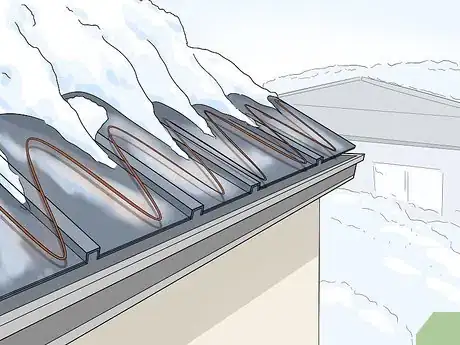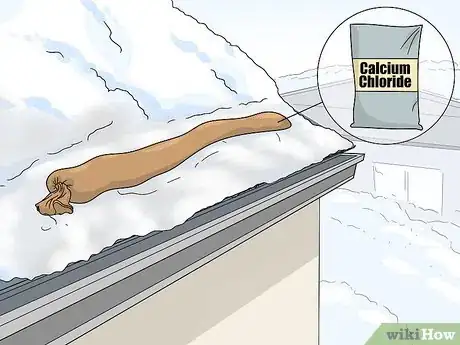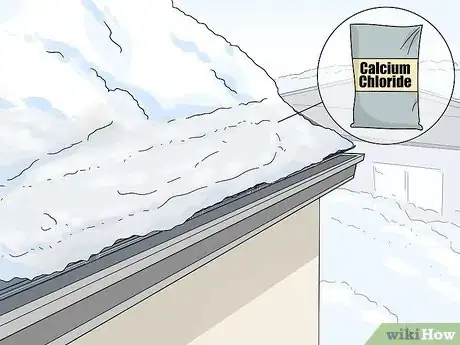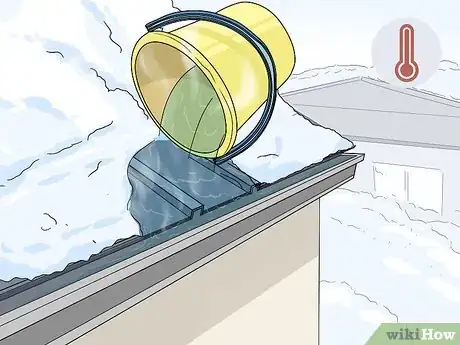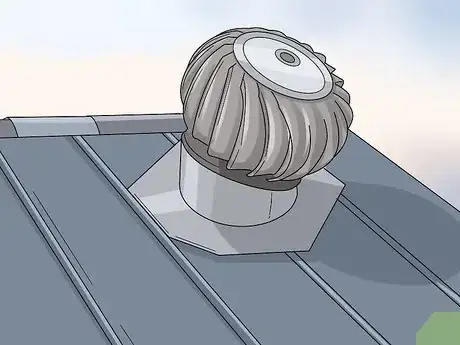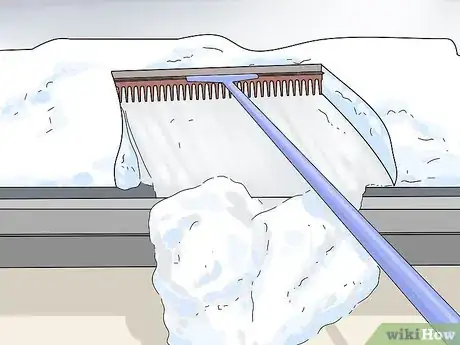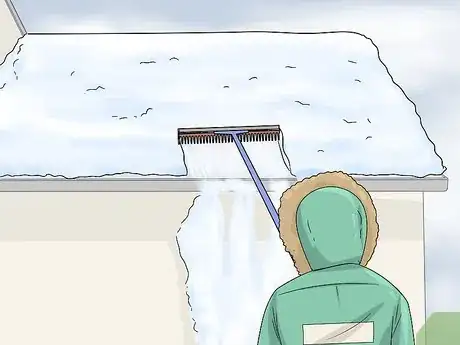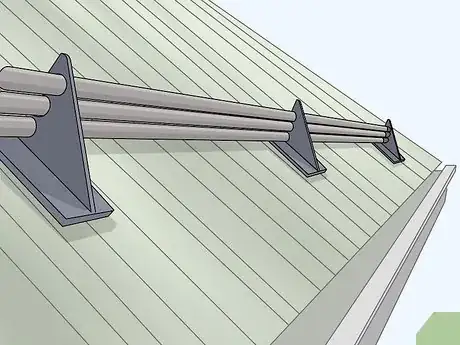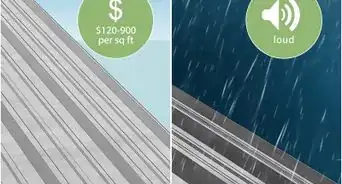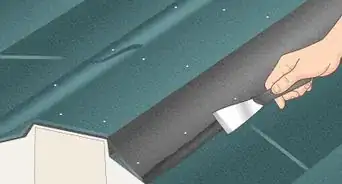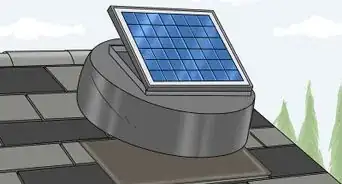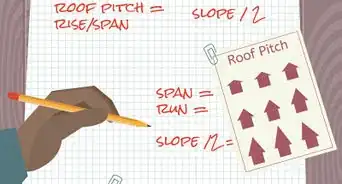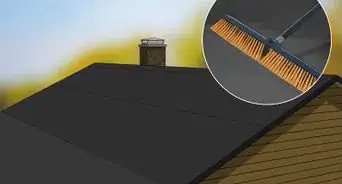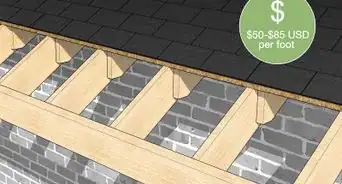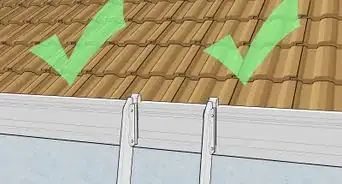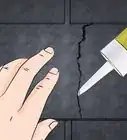This article was co-authored by Steve Linton. Steve Linton is the President of Deltec Homes, a custom home building company in Asheville, North Carolina. With nearly 20 years of experience, he oversees all home building projects for Deltec Homes. He specializes in hurricane-resistant homes, green home design, and sustainable building. Steve holds a BS in Structural Engineering from Cornell University and is a LEED Accredited Professional.
This article has been viewed 31,584 times.
A metal roof is great for preventing snow build-up because the sun heats up the metal and causes the snow to slide right off. If you still have snow or ice on your metal roof, there are several different tools you can use to melt the snow like heat cables, calcium chloride, or hot water. Whichever method you choose, avoid climbing up onto the roof to melt or remove the ice yourself so you don't get injured and call a professional if you need extra help.
Steps
Melting Ice Using Chemicals or Heat
-
1Install heat cables to melt the snow at the edge of the roof. These are also called deicing cables, and they can be found at your local hardware store or online. Use a ladder to carefully reach the top of your roof and use the clips that come with the cables to attach the cable to the roof. Position the cable so that it goes in a continuous 'W' shape along the edge of the roof, melting any snow that comes to the eaves.[1]
- Since the most snow and ice gathers at the edge of your roof, the heat cables help prevent this icy build up.
- The cables will need to be plugged in to a power source so they're working properly.
- Read the instructions that come with your specific brand of heat cables to be sure they're installed correctly.
-
2Fill pantyhose with sidewalk salt to break up ice at the edge of the roof. When your roof heats up and melts the bottom layer of snow or ice, the water leaks down to the edge of your roof and freezes again, creating an ice dam. To help prevent this, fill up a pair of pantyhose with the salt you’d use to get rid of ice on your sidewalk and tie off the ends. Place this vertically on your roof near the edge so it will melt a section of snow and ice, creating an area where the water can leak off.[2]
- Purchase sidewalk salt, also called calcium chloride, from your local hardware or big box store.
- Gently toss the tied-off pantyhose onto the edge of your roof to begin melting the snow.
Advertisement -
3Sprinkle a chemical deicer on the roof to get rid of large sections of snow. Purchase the salt you’d use to melt ice on a sidewalk or driveway from a local hardware or big box store. Wear gloves to protect your hands from the chemicals and throw small handfuls of the deicer onto the roof so it can start melting the snow.[3]
- Try to cover your roof in an even layer of the deicer.
- Look for a deicing chemical that is safe for your metal roof.
-
4Pour warm or hot water onto the snow to tackle problem areas. If you’re able to safely reach your roof using a stable ladder, fill a bucket or large spray bottle with warm or hot water and apply it directly onto the patch of snow or ice. This isn’t the best method for melting all of the snow off of your roof at once, but it’s great for targeting a specific spot. Continue pouring or spraying warm water until the snow starts to melt.[4]
- Position the ladder against the roof so you can reach the top and ask a friend or family member to stand at the bottom of the ladder to hold it in place, just in case.
-
5Make your attic the same temperature as the outdoors if you have one. This can be done by making sure there’s proper insulation and air ventilation in the attic to keep it the right temperature. Hire a professional to insulate the floor of the attic and install air ventilation. This will help seal off any gaps that let air pass through while also ensuring the air flows correctly.[5]
- Since heat rises, it’s common for the heat to escape out of the roof and begin melting the snow, forming ice dams.
- Do a quick online search to find insulation and air ventilation professionals in your area.
Removing and Preventing Snow Buildup
-
1Use a long-handled rake to remove the snow by hand. There are long-handled rakes designed specifically for removing snow from a roof, and they can be found at your local home improvement store or online. Hold the rake’s handle and position the rake as far up onto the roof as possible before pulling it downwards to remove the snow.[6]
- Stand as far back from the edge of the roof as possible so snow or ice doesn't fall on top of you as you're raking.[7]
- Avoid using a metal rake as this can scrape your roof and cause damage.
-
2Have a professional remove the snow from your roof to prevent any injuries. If there’s an overwhelming amount of snow on your roof or you’re just not sure you can do it yourself, consider hiring a professional. They will safely remove the snow so that you don’t have to worry about messing up your roof or getting injured in the process.[8]
- For example, some professionals have access to tools like steamers that are designed to melt the ice.
- To find a professional, type something like "professional roof snow removal company" into an online search bar.
-
3Add snow guards to the roof to prevent snow and ice build-up. Snow guards are pieces of metal that come in the shape of a small triangle or long rod, keeping the snow from building up at the edge of the roof. Position a ladder up against the house so you can reach the roof safely. Use screws and a screwdriver to attach each snow guard along the edge of the roof at least 1 ft (0.30 m) from the very edge. Spread them out evenly, referring to the instructions that come with the snow guards for the exact placement.[9]
- Have a professional install the snow guards if you're worried about damaging your metal roof.
- Purchase snow guards from your local hardware or home improvement store.
- Ask a friend or family member to hold the ladder on the ground to make sure it's stable.
Expert Q&A
-
QuestionHow do you prevent ice dams?
 Steve LintonSteve Linton is the President of Deltec Homes, a custom home building company in Asheville, North Carolina. With nearly 20 years of experience, he oversees all home building projects for Deltec Homes. He specializes in hurricane-resistant homes, green home design, and sustainable building. Steve holds a BS in Structural Engineering from Cornell University and is a LEED Accredited Professional.
Steve LintonSteve Linton is the President of Deltec Homes, a custom home building company in Asheville, North Carolina. With nearly 20 years of experience, he oversees all home building projects for Deltec Homes. He specializes in hurricane-resistant homes, green home design, and sustainable building. Steve holds a BS in Structural Engineering from Cornell University and is a LEED Accredited Professional.
Storm Resistant Home Builder Make sure that you have an even amount of insulation around the entire ceiling or attic area. Also, make sure that the roof ventilation is still occurring and not getting blocked by the insulation. Address any air leakage issues as well—these tend to occur near things like an attic hatch, a plumbing vent, a chimney, and recessed lights.
Make sure that you have an even amount of insulation around the entire ceiling or attic area. Also, make sure that the roof ventilation is still occurring and not getting blocked by the insulation. Address any air leakage issues as well—these tend to occur near things like an attic hatch, a plumbing vent, a chimney, and recessed lights.
References
- ↑ https://www.bobvila.com/articles/ice-dams/
- ↑ https://www.youtube.com/watch?v=5AGU5wDO0cw#t=1m18s
- ↑ https://www.moneycrashers.com/prevent-remove-ice-dams-roof-winter/#
- ↑ https://www.moneycrashers.com/prevent-remove-ice-dams-roof-winter/#
- ↑ https://www.youtube.com/watch?v=VcRPGQoeO9Q#t=1m15s
- ↑ https://www.bobvila.com/articles/ice-dams/
- ↑ https://www.fema.gov/media-library-data/7d8c55d1c4f815edf3d7e7d1c120383f/FEMA957_Snowload_508.pdf
- ↑ https://www.fema.gov/media-library-data/7d8c55d1c4f815edf3d7e7d1c120383f/FEMA957_Snowload_508.pdf
- ↑ https://www.asktoddmiller.com/snow-ice-dams-and-metal-roofing/
